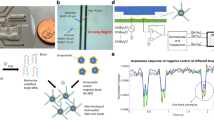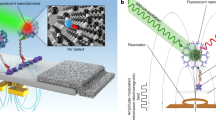Abstract
Here we describe a method for the sensitive detection of a single-base mutation in DNA. We assembled a primer thiolated oligonucleotide, complementary to the target DNA as far as one base before the mutation site, on an electrode or a gold–quartz piezoelectric crystal. After hybridizing the target DNA, normal or mutant, with the sensing oligonucleotide, the resulting assembly is reacted with the biotinylated nucleotide, complementary to the mutation site, in the presence of polymerase. The labeled nucleotide is coupled only to the double-stranded assembly that includes the mutant site. Subsequent binding of avidin–alkaline phosphatase to the assembly, and the biocatalyzed precipitation of an insoluble product on the transducer, provides a means to confirm and amplify detection of the mutant. Faradaic impedance spectroscopy and microgravimetric quartz-crystal microbalance analyses were employed for electronic detection of single-base mutants. The lower limit of sensitivity for the detection of the mutant DNA is 1 × 10−14 mol/ml. We applied the method for the analysis of polymorphic blood samples that include the Tay–Sachs genetic disorder. The sensitivity of the method enables the quantitative analysis of the mutant with no PCR pre-amplification.
This is a preview of subscription content, access via your institution
Access options
Subscribe to this journal
Receive 12 print issues and online access
$209.00 per year
only $17.42 per issue
Buy this article
- Purchase on Springer Link
- Instant access to full article PDF
Prices may be subject to local taxes which are calculated during checkout





Similar content being viewed by others
References
Winzler, E.A. et al., Direct allelic variation scanning of the yeast genome. Science 281, 1194–1197 (1998).
Boon, E.M., Ceres, D.M., Drummond, T.G., Hill, M.G. & Barton, J.K., Mutation detection by electrocatalysis at DNA-modified electrodes. Nat. Biotechnol. 18, 1096–1100 (2000).
Mikkelsen, S.R., Electrochemical biosensors for DNA sequence detection. Electroanalysis 8, 15–19 (1996).
Rodriguez, M. & Bard, A.J., Electrochemical studies of the interaction of metal chelates with DNA. 4. Voltammetric and electrogenerated chemiluminescent studies of the interaction of tris(2,2′-bipyridine)osmium(II) with DNA. Anal. Chem. 62, 2658–2662 (1990).
Adleman, L.M. Molecular computation of solutions to combinatorial problems. Science 266, 1021–1024 (1994).
Liu, Q.H., Frutos, A.G., Thiel, A.J., Corn, R.M. & Smith, L.M., DNA computing on surfaces: encoding information at the single base level. J. Comput. Biol. 5, 269–278 (1998).
Frutos, A.G., Smith, L.M. & Corn, R.M., Enzymatic ligation reactions of DNA 'words' on surfaces for DNA computing. J. Am. Chem. Soc. 120, 10277–10282 (1998).
Jordan, C.E., Frutos, A.G., Thiel, A.J. & Corn, R.M., Surface plasmon resonance imaging measurements of DNA hybridization adsorption and streptavidin/DNA multilayer formation at chemically modified gold surfaces. Anal. Chem. 69, 4939–4947 (1997).
Korri-Youssoufi, H., Granier, F., Srivastava, P., Godillot, P. & Yassar, A., Towards bioelectronics: specific DNA recognition based on an oligonucleotide- functionalized polypyrrole. J. Am. Chem. Soc. 119, 7388–7389 (1997).
Millan, K.M., Saraullo, A. & Mikkelsen, S.R., Voltammetric DNA biosensor for cystic-fibrosis based on a modified carbon-paste electrode. Anal. Chem. 66, 2943–2948 (1994).
Hashimoto, K., Ito, K. & Ishimori, Y., Sequence-specific gene detection with a gold electrode modified with DNA probes and an electrochemically active dye. Anal. Chem. 66, 3830–3833 (1994).
Bardea, A., Patolsky, F., Dagan, A. & Willner, I., Sensing and amplification of oligonucleotide–DNA interactions by means of impedance spectroscopy: a route to a Tay–Sachs sensor. Chem. Commun. pp. 21–22 (1999).
Wang, J. et al., Peptide nucleic acid probes for sequence-specific DNA biosensors. J. Am. Chem. Soc. 118, 7667–7670 (1996).
Bardea, A., Dagan, A., Ben-Dov, I., Amit, B. & Willner, I., Amplified microgravimetric quartz crystal microbalance analysis of oligonucleotide complexes: a route to Tay–Sachs biosensor device. Chem. Commun. pp. 839–840 (1998).
Caruana, D.J. & Heller, A. Enzyme amplified amperometric detection of hybridization and of a single base pair mutation in an 18-base oligonucleotide on a 7-μm diameter microelectrode. J. Am. Chem. Soc. 121, 769–774 (1999).
Land, H., Parada, L.F. & Weinberg, R.A., Cellular oncogenes and multistep carcinogenesis. Science 222, 771–777 (1983).
Almoguera, C. et al., Most human carcinomas of the exocrine pancreas contain mutant c-K-ras. Cell 53, 549–554 (1988).
Watanabe, H. et al. K-ras mutations in duodenal aspirate without seretin stimulation for screening of pancreatic and biliary tract carcinoma. Am. Cancer Soc. 86, 1441–1448 (1999).
Patolsky, F., Zayats, M., Katz, E. & Willner, I., Precipitation of an insoluble product on enzyme monolayer electrodes for biosensor applications: characterization by Faradaic impedance spectroscopy, cyclic voltammetry and microgravimetric quartz crystal microbalance analyses. Anal. Chem. 71, 3171–3180 (1999).
Patolsky, F., Katz, E., Bardea, A. & Willner, I., Enzyme linked amplified electrochemical sensing of oligonucleotide–DNA interactions by means of precipitation of an insoluble product and using impedance spectroscopy. Langmuir 15, 3703–3706 (1999).
Steel, A.B., Herne, T.M. & Tarlov, M.J., Electrochemical quantification of DNA immobilized on gold. Anal. Chem. 70, 4670–4677 (1998).
Schafer, A.J. & Hawkins, J.R. DNA variation and the future of human genetics. Nat. Biotechnol. 16, 33–39 (1998).
Cargill, M. et al. Characterization of single-nucleotide polymorphisms in coding regions of human genes. Nat. Genet. 22, 231–238 (1999).
Gravel, R.A. et al. The GM2 gangliosides. In The metabolic and molecular bases of inherited diseases, Vol. 2. (eds Scriver, C.R., Beaudet, A.L., Sly, W.S. & Valle, D.) 2839–2879 (McGraw-Hill, New York; 1995).
Myerowitz, R. & Costigan, F.C., The major defect in Ashkenazi Jews with Tay–Sachs disease is an inversion in the gene for the α-chain of β-hexosaminidase. J. Biol. Chem. 263, 18587–18589 (1988).
Acknowledgements
Parts of the research are supported by the Max Planck Research Award for International Cooperation and by the Israel Ministry of Science as an Infrastructure Project in Biomicroelectronics.
Author information
Authors and Affiliations
Corresponding author
Rights and permissions
About this article
Cite this article
Patolsky, F., Lichtenstein, A. & Willner, I. Detection of single-base DNA mutations by enzyme-amplified electronic transduction. Nat Biotechnol 19, 253–257 (2001). https://doi.org/10.1038/85704
Received:
Accepted:
Issue Date:
DOI: https://doi.org/10.1038/85704
This article is cited by
-
A multiplexed, electrochemical interface for gene-circuit-based sensors
Nature Chemistry (2020)
-
Electrochemical CYFRA21-1 DNA sensor with PCR-like sensitivity based on AgNPs and cascade polymerization
Analytical and Bioanalytical Chemistry (2020)
-
Detection of KRAS mutation via ligation-initiated LAMP reaction
Scientific Reports (2019)
-
Rich-color visual genotyping of single-nucleotide polymorphisms based on platinum nanoparticle–induced etching of gold nanorods
Emergent Materials (2019)
-
Fluorometric determination of HIV DNA using molybdenum disulfide nanosheets and exonuclease III-assisted amplification
Microchimica Acta (2019)



